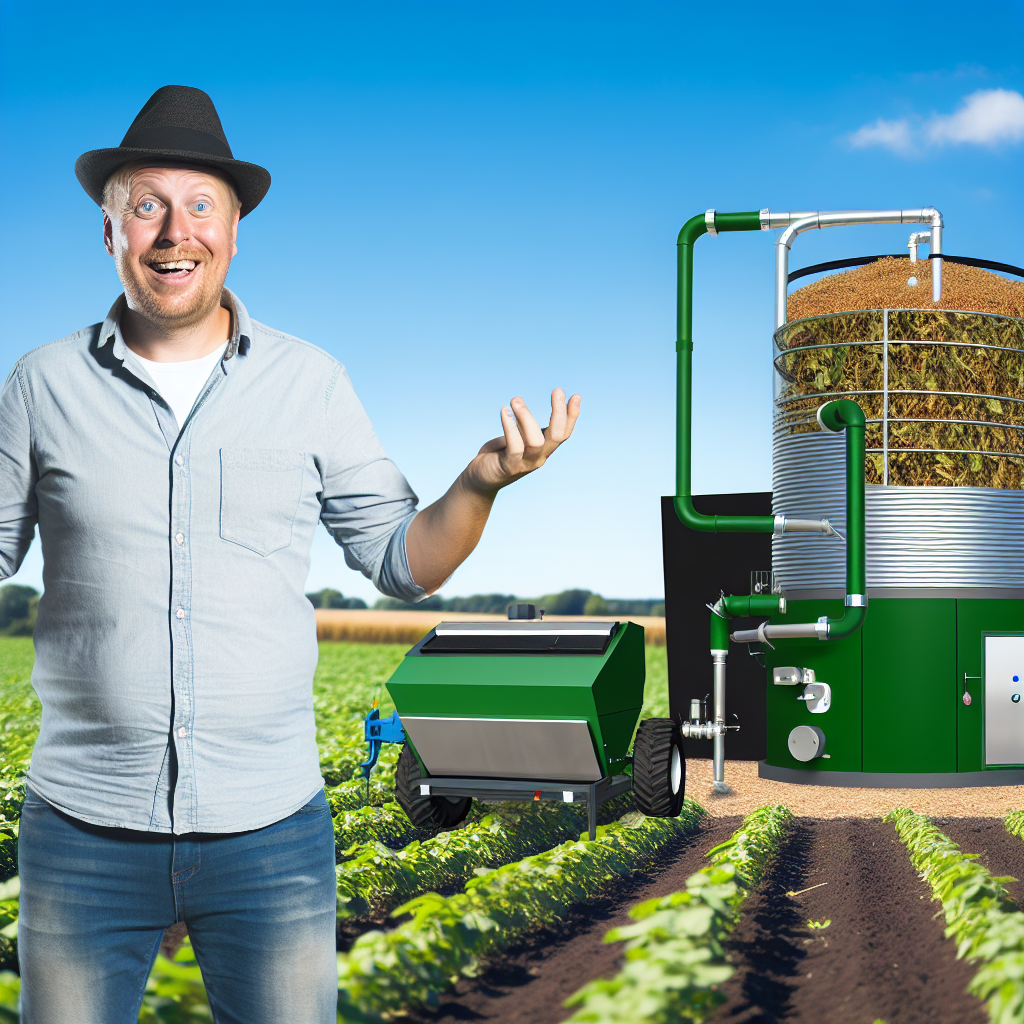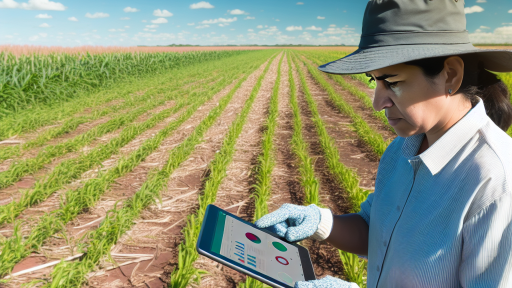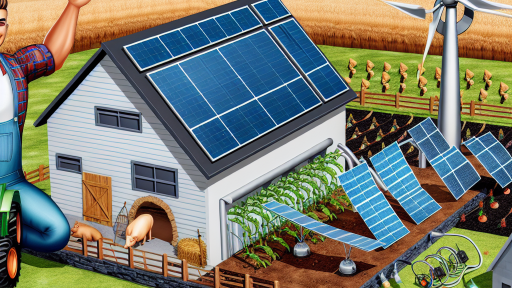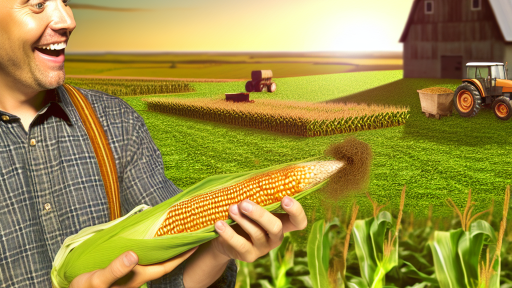Introduction to Biomass Energy
Definition of Biomass Energy
Biomass energy comes from organic materials.
It includes plant matter, animal waste, and other biological materials.
Farmers can harness this energy for various sustainable practices.
Importance in Sustainable Agriculture
Biomass energy significantly reduces reliance on fossil fuels.
It contributes to a decrease in greenhouse gas emissions.
This energy source promotes resource conservation on farms.
Farmers can utilize waste materials to create energy.
Thus, they can minimize waste and enhance efficiency.
Benefits of Biomass Energy
Utilizing biomass energy can lower energy costs for farmers.
It provides a renewable energy option, enhancing sustainability.
Moreover, it fosters local economic growth through energy independence.
Farmers can create additional income by selling surplus energy.
Challenges and Considerations
Adopting biomass energy may face some hurdles.
One challenge is the initial investment cost for technology.
Another concern is the availability of sustainable biomass sources.
Transform Your Agribusiness
Unlock your farm's potential with expert advice tailored to your needs. Get actionable steps that drive real results.
Get StartedFarmers must ensure they do not over-exploit resources.
Balancing biomass production with food crop cultivation is essential.
Overview of Biomass Sources
Agricultural Residues
Agricultural residues are abundant sources of biomass energy.
They include leftover materials from farming activities.
Common examples are straw, husks, and leaves.
These materials can be converted into various energy forms.
Using agricultural residues supports sustainability and waste reduction.
Farmers can utilize residues to create bioenergy and biofuels.
This process not only provides energy but also enriches soil health.
Animal Manure
Animal manure is another significant biomass resource.
It can be collected from various livestock, including cattle and chickens.
Manure contains high levels of nutrients and organic matter.
This makes it an excellent candidate for energy production.
Through anaerobic digestion, manure can produce biogas.
Biogas can be harnessed for heating, electricity, or vehicle fuel.
Utilizing manure reduces greenhouse gas emissions effectively.
Energy Crops
Energy crops are specifically grown for biomass energy production.
They offer higher yields compared to traditional crops.
Common energy crops include switchgrass, miscanthus, and giant reed.
These crops are designed to thrive in various environmental conditions.
They can be cultivated on marginal lands, preserving arable soil.
Additionally, energy crops contribute to carbon sequestration.
This practice delivers both energy and eco-friendly benefits.
The Process of Biomass Conversion: Technologies and Key Methods
Overview of Biomass Conversion
Biomass conversion involves transforming organic materials into energy.
Showcase Your Farming Business
Publish your professional farming services profile on our blog for a one-time fee of $200 and reach a dedicated audience of farmers and agribusiness owners.
Publish Your ProfileThis process plays a vital role in sustainable farming practices.
Farmers often use byproducts from crops and livestock as feedstocks.
Consequently, they reduce waste and create renewable energy sources.
Types of Biomass Technologies
Several technologies exist for biomass conversion.
These technologies include biological, thermal, and chemical methods.
Biological methods utilize microorganisms to decompose organic matter.
Thermal methods involve heating the biomass to produce energy.
Chemical methods use chemical reactions to convert biomass into fuel.
Biological Conversion Techniques
Fermentation is a popular biological conversion technique.
This method transforms sugars into ethanol using yeast.
Additionally, anaerobic digestion breaks down organic material in the absence of oxygen.
This process produces biogas, which can be used for heating or electricity.
Thermal Conversion Techniques
Pyrolysis is a common thermal conversion method.
It involves heating biomass in a low-oxygen environment.
This method generates bio-oil, charcoal, and gas.
Gasification is another thermal method that converts biomass into synthetic gas.
This gas can be burned to generate electricity or processed into fuels.
Chemical Conversion Techniques
Transesterification is a key chemical conversion process.
This method converts oils and fats into biodiesel.
Additionally, hydrothermal liquefaction changes wet biomass into liquid biofuel.
These fuels can replace traditional petroleum-based fuels.
Challenges and Considerations
Despite the benefits, biomass conversion faces challenges.
High initial costs can hinder widespread adoption.
Moreover, sourcing sufficient biomass feedstock requires careful planning.
Farmers must also ensure sustainable practices in collecting materials.
Future of Biomass Energy in Farming
The future of biomass energy is promising.
Advancements in technology will enhance efficiency and reduce costs.
Furthermore, increasing awareness of environmental issues will drive adoption.
As a result, biomass energy can significantly contribute to sustainable farming.
Gain More Insights: Integrating GMO Crops Into Traditional Farming Systems
Benefits of Biomass Energy for Farming
Environmental Advantages
Biomass energy significantly reduces greenhouse gas emissions.
It utilizes organic waste, decreasing landfill contributions.
This energy source promotes sustainable farming practices.
By enhancing soil health, it supports biodiversity.
Moreover, it helps combat climate change effects.
Economic Advantages
Biomass energy offers farmers cost-effective energy solutions.
It reduces reliance on fossil fuels, lowering operational costs.
This approach can increase farm profitability over time.
Furthermore, it creates job opportunities in rural areas.
Investing in biomass technologies attracts government incentives.
Showcase Your Farming Business
Publish your professional farming services profile on our blog for a one-time fee of $200 and reach a dedicated audience of farmers and agribusiness owners.
Publish Your ProfileEnhanced Soil Fertility
Biomass can be used to produce organic fertilizers.
These fertilizers improve soil structure and nutrient content.
Hence, farmers achieve higher crop yields sustainably.
Energy Independence
Biomass energy contributes to energy independence for farms.
It minimizes the impact of volatile fossil fuel markets.
Farmers can produce energy on-site, enhancing security.
This self-sufficiency leads to more resilient farming operations.
See Related Content: Top Features To Look For In Farm Management Software Solutions
Case Studies: Successful Biomass Energy Implementations in Farming
Innovative Use of Biomass in Dairy Farming
Green Valley Dairy implemented a biomass energy system in 2021.
This system converts animal waste into biogas for energy production.
As a result, the farm reduced its energy costs by 30% within the first year.
Moreover, it created a sustainable approach to waste management.
Integrating Biomass for Crop Production
This method utilizes wood chips sourced from local forests.
Consequently, they decreased reliance on fossil fuels.
This change allowed them to maintain optimal growing temperatures year-round.
Additionally, it improved their carbon footprint significantly.
Enhancing Soil Fertility through Biomass
Maple Leaf Farms uses biomass materials to enhance soil health.
They implemented a composting program using leftover plant materials.
This compost enriches the soil and promotes better crop yields.
Furthermore, it reduces landfill waste, benefiting the environment.
Community Engagement and Biomass Energy
Pine Grove Community Cooperative partnered with local farmers.
They developed a biomass energy project to serve the entire community.
This initiative converts agricultural residues into renewable energy.
As a result, community members have access to cheaper and cleaner energy.
This project also encourages collective sustainability efforts.
Future Prospects for Biomass Energy in Agriculture
Experts foresee an increasing trend in biomass energy use in farming.
With advancements in technology, efficiency will improve further.
Additionally, government incentives will boost adoption rates.
Farmers are more likely to explore these sustainable alternatives.
Biomass energy solutions will play a pivotal role in sustainable agriculture.
Explore Further: Optimizing Crop Investments Through Advanced Agri-Fintech Platforms

Challenges and Limitations
Regulatory Barriers
Regulatory frameworks often hinder the adoption of biomass energy solutions.
Farmers face complex laws related to biomass procurement and usage.
Additionally, inconsistent regulations across regions create confusion.
Compliance with environmental standards adds to operational complexity.
Some regulations may inadvertently favor fossil fuels over biomass options.
Economic Constraints
Economic feasibility remains a significant concern for many farmers.
High upfront costs can deter investments in biomass energy systems.
Moreover, uncertain market prices for biomass fuel affect profitability.
Showcase Your Farming Business
Publish your professional farming services profile on our blog for a one-time fee of $200 and reach a dedicated audience of farmers and agribusiness owners.
Publish Your ProfileFarmers may lack access to financial incentives or subsidies.
These financial barriers can hinder widespread adoption in the agricultural sector.
Technical Limitations
Technical challenges arise in converting biomass to energy effectively.
Farmers may not have access to the necessary technology for efficient processing.
Operational challenges in handling and storing biomass products exist as well.
Moreover, maintenance of biomass systems can be complicated and costly.
Technical training and support for farmers are often insufficient.
Adoption Hurdles
Resistance to change plays a crucial role in limiting biomass adoption.
Many farmers prefer traditional energy sources due to familiarity.
Moreover, a lack of awareness about biomass benefits contributes to hesitation.
Social perception can also influence the decision-making process.
Effective communication and education are essential to overcome this obstacle.
Explore Further: Maximizing Profitability With Automated Farming Equipment
Integrating Biomass Energy with Other Renewable Sources
Importance of a Holistic Approach
A holistic approach enhances the effectiveness of biomass energy solutions.
This method combines various renewable energy sources.
Such integration promotes sustainable farming practices and reduces reliance on fossil fuels.
Synergy of Energy Sources
Integrating solar power with biomass energy maximizes resource use.
Solar panels can generate electricity during sunny days.
On cloudy days, biomass energy ensures farms remain operational.
This synergy balances energy supply and demand effectively.
Utilizing Wind Energy
Wind turbines can complement biomass energy systems well.
Their combined use can stabilize energy costs for farmers.
Moreover, they reduce greenhouse gas emissions together.
Enhancing Energy Efficiency
Farmers can implement energy efficiency measures alongside biomass solutions.
For example, using energy-efficient machinery reduces overall energy demand.
Moreover, optimizing irrigation systems decreases unnecessary energy use.
Collaboration with Energy Providers
Partnerships with energy providers can enhance biomass projects.
Collaborating allows access to expertise and funding.
Additionally, it promotes a wider adoption of renewable energy solutions.
Challenges and Considerations
Integration presents challenges that require careful planning.
Potential land use conflicts may arise with biomass projects.
Farmers should assess environmental impacts before implementation.
Adopting a phased approach can help mitigate risks effectively.
Future Trends in Biomass Energy
Innovative Biomass Conversion Technologies
New biomass conversion technologies are emerging constantly.
These technologies focus on improving efficiency and reducing emissions.
For instance, advanced fermentation processes can enhance biofuel production.
Additionally, gasification processes can convert biomass into synthetic gas.
This gas can serve as a clean energy source for various applications.
Integration with Agricultural Practices
Integrating biomass energy with farming practices is becoming essential.
Farmers can use crop residues to generate energy on-site.
Showcase Your Farming Business
Publish your professional farming services profile on our blog for a one-time fee of $200 and reach a dedicated audience of farmers and agribusiness owners.
Publish Your ProfileThis practice reduces waste and provides a renewable energy source.
Moreover, biomass energy can power agricultural machinery effectively.
This integration can lower dependency on fossil fuels in farming.
Research Directions in Biomass Energy
Ongoing research in biomass energy focuses on optimizing feedstocks.
Scientists are exploring various plant species for energy production.
Utilizing invasive species for biomass could prevent ecological harm.
Moreover, researchers aim to improve the conversion processes further.
This will maximize energy output while minimizing costs.
Policy and Economic Incentives
Government policies are supporting biomass energy initiatives.
Subsidies and grants encourage farmers to adopt biomass technologies.
Tax incentives are also available for developing biomass facilities.
These economic incentives are crucial for fostering innovation.
Furthermore, policy frameworks are essential to ensure sustainability.
Future Applications of Biomass Energy
The future of biomass energy holds various promising applications.
Biomass can fuel electric generators in rural areas effectively.
This can increase energy access for remote farming communities.
Additionally, biomass energy can be used in bioprocessing industries.
This supports the production of bio-based chemicals and materials.
Additional Resources
How to Sustainably Feed 10 Billion People by 2050, in 21 Charts …
Possibility of utilizing agriculture biomass as a renewable and …




